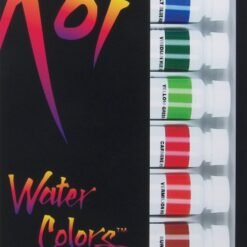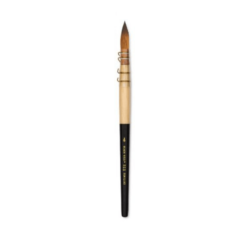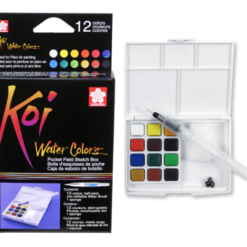No products in the basket.
Art Shopping Lists
Essential Watercolour Supplies
If you are a beginner at watercolour painting, then be sure to get everything that is mentioned in the Essential Watercolour Supplies list. These are the things you really cannot do a watercolour painting without.
Watercolours are considered the hardest medium to learn. The reason being that this medium is very un-forgiving, once you make an error; you need to re-start your painting. Other mediums such as oils, allows you to hide a myriad of mistakes. Non-the-less, it is a beautiful medium with stunning translucent effects that no other medium can achieve. It is also the perfect medium to travel with since the kit is small. In this post, you will find out what watercolour painting supplies you’ll need to begin painting with watercolours.
The great news is that you actually don’t need that many supplies to get started with watercolours.
This makes watercolour painting an affordable pastime. Even if you just have a beginner’s set, you can still make some beautiful art!
If you are starting to get serious about your artwork, no matter what age, you may also be starting to get serious about the materials that you use. Rather opt for the best watercolour supplies.
Watercolour Essentials
To get started with watercolour painting, you will need these 5 essential watercolour painting supplies: paints, paintbrushes, watercolour paper, a palette, a container of water.
1. Paint
Watercolours come in 2 forms: tubes and pans. Tubes of watercolours are already moist, with a pasty consistency. Pans of watercolours are like hard cakes of paint that need to be moistened with water to be used.
Please buy the pans. This allows you to add your own amount of moisture and truly understand how to mix watercolours.
Watercolour paints are also available in 2 types of quality: Artist Quality and Student Quality. The Student Quality watercolours are more affordable, but they contain more filler and less pigment than their Artist Quality counterparts. You basically get what you pay for. With Artist Quality watercolours, you can achieve more subtleties with colour and transparency. If you can afford it, please buy Artist Quality. It does make a massive difference.
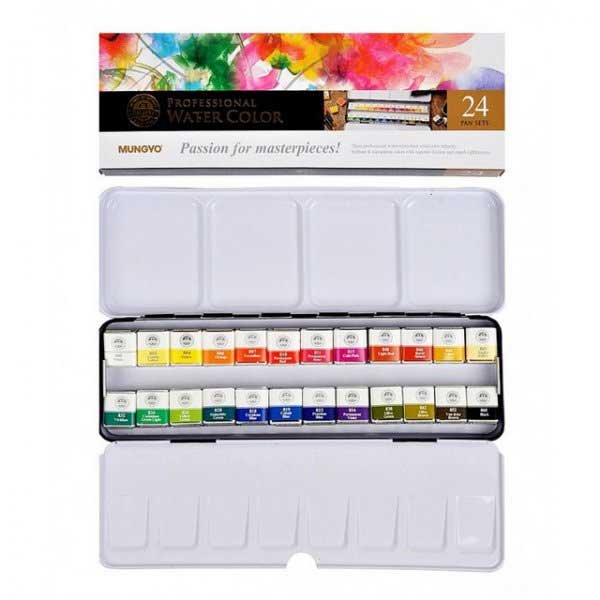
2. Brushes
When buying watercolour brushes, you have 3 choices to consider: hair, size, and shape. If you’re a beginner, all the info below about brushes might overwhelm you – so I’ll tell you what you need to know in a nutshell:
Quick Beginner’s Guide to Watercolour Brushes:
Natural brushes are better than synthetics, and if you can only afford one brush, choose a natural round brush. If you can afford two brushes, get a small round and a medium round.
This is all you need to get started – you can worry about the other sizes and shapes later!
If you’re on a budget, you’ll be happy to know that you can create an entire watercolour painting using just one brush!
If you’re ready to learn more about watercolour brushes, read on…
Hair – Natural hair paintbrushes are the best choice for painting with watercolours, but they can also be costly. Sable hair is the most revered, but they last a lifetime.
Other types of hair used to create watercolour brushes include ox hair, which is ideal for square brushes; squirrel hair, which is ideal for mop brushes; and goat hair, which is ideal for creating large washes.
If you are on a budget, there are some good synthetic brushes you can try that work well with watercolours. With the right care, they can last a long time, but will likely not last a lifetime. Synthetic brushes may need to be replaced every few years.
Size – Watercolour Brushes come in sizes ranging from super-tiny to somewhat large.
A range of sizes is nice, but you don’t need that many because watercolour brushes are so versatile.
A medium or large round brush, for example, is sufficient for creating both large washes of colour and for creating fine details, so you can use the same brush for both functions.
Shape – Watercolour brushes are available in several different shapes that serve different functions:
- Angular – The hairs are cut at an angle (hence the name). Can be used for precise strokes.
- Flat – Can hold lots of colours. The edge can be used for sharp lines, but the brush can also be used to fill in broad areas with colour.
- Square Wash – Looks like a short, stumpy version of the flat brush. Ideal for wetting the paper or laying in washes.
- Mop – Great for wetting your paper and laying in large areas of colour quickly.
- Oval Wash – These brushes look kind of puffy, like a make-up brush. Used for wetting paper and laying large washes of colour quickly. These brushes never form a point or an edge.
- Script / Liner – Pointy, narrow brush for executing fine details.
- Round – The best “all-around” brush. The round brush can be used for both details and washes. You can change the width of your lines by varying your angle and pressure.
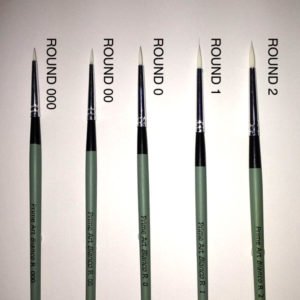
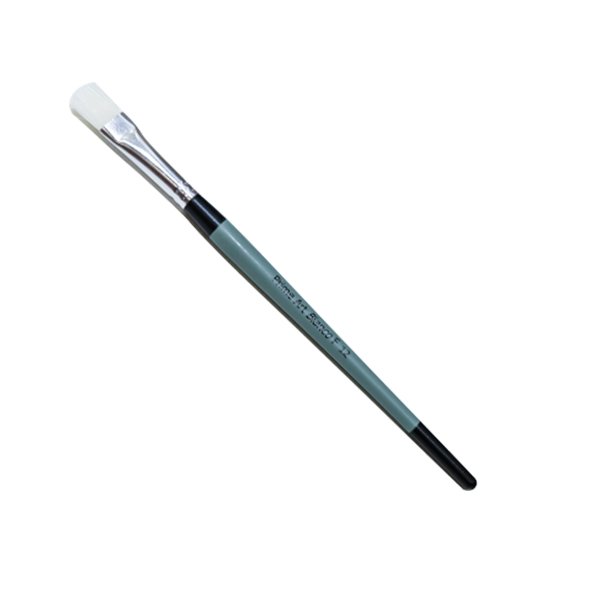
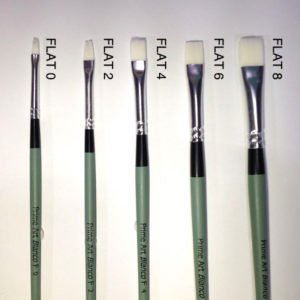
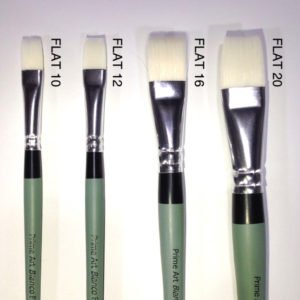
3. Pallet
Most watercolour palettes are either plastic or ceramic. Ceramic palettes are better quality; the plastic palettes will eventually become stained with the paint, but plastic palettes are lighter and easier to hold.
Choose a palette that has separate wells that you can mix your colours in. The walls of the wells will keep the colours separate, otherwise the watery paint may just run into each other. This causes your pigment to turn ‘dirty’.
If you use pan watercolours, you can also use the plastic lid of the watercolour set as a palette. Just be sure that the lid is dry when you close it.
In a pinch, you can use tin foil or a dinner plate as a palette. Just be sure to space the colours far enough apart that they don’t run into each other!

4. Water Container
A glass, jar or cup of water is essential. It’s best if your container is clear so that you can see how clean or dirty the water is. It’s important to change the water when it becomes too murky; otherwise, the residue can get onto your brush and wind up on your painting.
Some artists use 2 containers of water – one full of clean water for dipping, and one for rinsing in-between colours.
Phew! Congratulations, you’ve just gotten through the list of Essential Watercolor Painting Supplies!
Extra Watercolour Supplies
Paper towels – Handy for squeezing out excess paint and water from your brush, and also for dabbing at mistakes.
Pencil – If you want to sketch in your composition before painting, use a pencil. The lighter, the better! Choose something like a 2H over an HB or 2B, for example.
Eraser – Use an eraser to erase those pencil marks if you make a mistake or if they get too dark! I prefer a kneaded rubber because you can mould it to any shape you need.
Board – Depending on how your studio is set up, you may need to attach your watercolour paper to a board.
Clips – Clips can be used to attach your watercolour paper to your board.
Tape – You can also tape your watercolour paper to your board, using an acid-free artist tape. Tape can also be used as a mask.
Ruler – A ruler is handy for measuring and marking the boundaries of your paper, as well as aiding with any straight lines you may need.
Mediums – There are a whole range of watercolour mediums that can alter the characteristics of watercolours, for instance by extending the drying time or increasing transparency. When you’re just starting out, it’s best to get used to watercolours as they are – so if you are a beginner, you can safely ignore these mediums for now!
Masking Fluid – is used to “mask” certain areas of your painting. According to me, this is a must have.
Spray varnish – When your painting is finished, a spray varnish can protect your watercolour painting by making it waterproof. Some spray varnishes also carry UV protectants.
Watch and paint along with Lillian Gray in these videos:
 Fabriano Artistico Watercolour Block A3 300gsmR800.00
Fabriano Artistico Watercolour Block A3 300gsmR800.00 Watercolour Sakura Koi 12 Watercolour TubesR360.00
Watercolour Sakura Koi 12 Watercolour TubesR360.00 Watercolor Dynasty Quill Black Gold 6 – Prime ArtR352.00
Watercolor Dynasty Quill Black Gold 6 – Prime ArtR352.00 Watercolor Dynasty Quill Brush Black Gold 4 – Prime ArtR295.00
Watercolor Dynasty Quill Brush Black Gold 4 – Prime ArtR295.00 Watercolor Dynasty Quill Brush Black Gold 000 – Prime ArtR126.00
Watercolor Dynasty Quill Brush Black Gold 000 – Prime ArtR126.00 Watercolour Sakura Koi Pocket Field Sketch Box 12 pieceR345.00
Watercolour Sakura Koi Pocket Field Sketch Box 12 pieceR345.00



